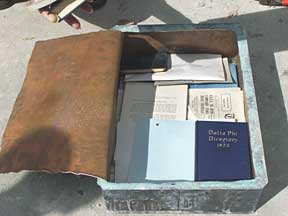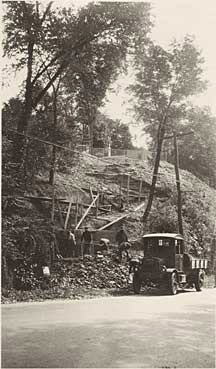Soldier who fell in World War I will be remembered in Veterans Day ceremony with replacement of Baldwin Memorial Stairway time capsule
By Franklin Crawford
Morgan Smiley Baldwin, Cornell Class of 1915, is buried in France where he died from wounds received during the Battle of the Hindenburg Line, the last major offensive of World War I.
Baldwin, who was killed about a month before the war ended, was a member of Delta Phi fraternity, and his fraternity pin and ribbon were among the items discovered Sept. 26 in a sealed copper box nested in the base of a pier on the parapet of the Baldwin Memorial Stairway on University Avenue just below Delta Phi's Gothic fraternity (Llenroc).
On Nov. 11 at 1 p.m., Baldwin's Delta Phi effects and other Cornell memorabilia from the box -- as well as some new items -- will be re-interred during a Veterans Day ceremony with full military honors, held at the site. The event is an 81-year-old echo of the original placement ceremony that occurred on Armistice Day, Nov. 11, 1925, the year the stairway was erected.
It's no secret that the Baldwin Memorial Stairway is a monument to one of Cornell's fallen sons. But institutional memory sometimes needs prodding, and it is safe to say that no living person was aware that a time capsule lay within its stoneworks. In September, Cornell masons replacing and repairing the shale stone on the stairway's overlook tapped into what at first appeared to be tin flashing or a hidden drain. Worked stopped. After some effort, a metal box was removed. So began a series of excited calls to supervisors, facilities managers and university librarians.
At 1:30 p.m. that Sept. 26 afternoon, a Cornell tinsmith from the Humphreys Service Building laid open the well-soldered container. As the Cornell alma mater tolled from McGraw Tower (mere coincidence, but a nice touch), a group of university staff, including librarians, trades people and administrators, stood witness.
Once the box was unsealed, Elaine Engst, university archivist, removed each item: None had seen the light of day since 1925. The contents included perfectly preserved copies of the Cornell Daily Sun, Nov. 10, 1925; a copy of The Ithaca Journal; original blueprints of the stairway designed by Bryant Fleming, Cornell Class of 1901; pictures of the construction; a Freshman Handbook, 1925; Cornell Class of 1892, 33rd anniversary class book; lists of Cornellians killed during World War I (265; Cornell had provided 4,598 commissioned officers, more than West Point) and Tompkins County war dead; and Baldwin's Delta Phi pin, fraternity ribbon and a directory; memorial programs; and other items.
The documents told how the stairway was a gift to Cornell from a grieving father, Arthur J. Baldwin, Class of 1892, to memorialize his son. Donald R. Baldwin, Class of 1916, Morgan's brother, helped to lay the stairway cornerstone. The box was placed by George S. Tarbell, president of Delta Phi fraternity, of which all the Baldwins were members.
Engst said all of the university's older buildings contain cornerstone boxes with similar materials to those found in the stairway -- and these are indicated in the building plans. One was found when Roberts Hall was demolished in the late 1980s and another when Sage Hall was renovated (1996-98). But the Baldwin time capsule had been forgotten until this fall.
A new box made of stainless steel will replace the container during Saturday's ceremony. Among the items it will contain: New letters from the Baldwin family and a copy of the Cornell Chronicle bearing this story and photographs.
Photos courtesy of the Cornell Library Division of Rare and Manuscript Collections.
Media Contact
Nicola Pytell
Get Cornell news delivered right to your inbox.
Subscribe

